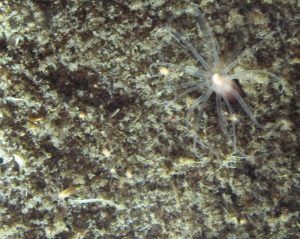Cnidarian Circadian Rhythms
 Circadian rhythms regulate many aspects of animal biology, from cycles of sleep and wakefulness to variations in energetic metabolism. We study circadian regulation in the sea anemone Nematostella both to gain insight into cnidarian physiology and to better understand the evolution of the animal circadian clock.
Circadian rhythms regulate many aspects of animal biology, from cycles of sleep and wakefulness to variations in energetic metabolism. We study circadian regulation in the sea anemone Nematostella both to gain insight into cnidarian physiology and to better understand the evolution of the animal circadian clock.
A few things we’ve learned and questions that still keep us up at night:
- Nematostella shares many conserved circadian regulatory genes with other (bilaterian) animals. There is an ancient origin of circadian signaling in animals. But key circadian genes (period, timeless) seem to be restricted to bilaterians. How does the clock function in Nematostella without these pieces?
- We've demonstrated that Nematostella's Clock and Cycle proteins can form heterodimers in vitro and that promotors of many rhythmic genes are enriched in e-box motifs, which are binding sites for the bilaterian homologs. Beyond this, we know very little as to the circadian regulatory mechanisms in cnidarians. For example, What are the direct targets of Clock and Cycle in Nematostella? Do Clock-like and/or ARNT also play roles in circadian regulation? How do the abundances of these proteins and their subcellular localization vary on daily timescales?
- Nematostella clearly has a circadian timer that regulates activity patterns and expression of several genes. But how does circadian regulation affect the physiology of these animals? Why do they need a clock at all??
- We’ve learned that light, especially blue light, can entrain circadian rhythms in Nematostella. More recently we have shown that temperature cycles can also entrain circadian rhythms (Berger et al. in revision; BioRxiv preprint). We've also shown that the dominant behavioral rhythm in field-collected animals is circadian, not circatidal (paper and blog post). How are circadian rhythms affected by environmental variation, such as nighttime illumination or variation in tidal amplitude?
- How do redox state and other aspects of cellular physiology cycle over daily or tidal periods?
We are actively seeking funding to continue this work...
Circadian Regulation in the Real World
We've taken a few steps to understand how circadian rhythms are entrained and create organisms phenotypes in natural environments, but we still have a long way to go. Some thoughts:
An approach we have used is to sample Nematostella directly from the field and measure transcriptional and behavioral rhythms (Tarrant et al. 2019; Leach et al. in preparation). This approach is simple in principle but challenging in practice. For example, we don't have a good way to observed behavior directly in the field, so we collect animals from the field and observe them in the lab after a minimal acclimation period. This approach likely creates some artifacts due to disruption associated with sampling and transition to the lab environments.
Another approach is the make the lab environments more similar to field environments. We have begun moving in this direction. For example, Cory Berger has been interested in the combined influences of light and temperature as entraining cues. tested the effects of more natural (gradually ramped) temperature cycles combined with light cycles that were either aligned or offset in timing. We currently use binary (on-off) light cycles, but would be interested in testing the effects of more natural changes in light level. All of our behavioral observations have been made using Nematostella lying in multi-well dishes. This is very different from the natural environment in which Nematostella burrows into sediment. Can we develop an imaging system to track behavior within sediment or a sediment-like matrix?